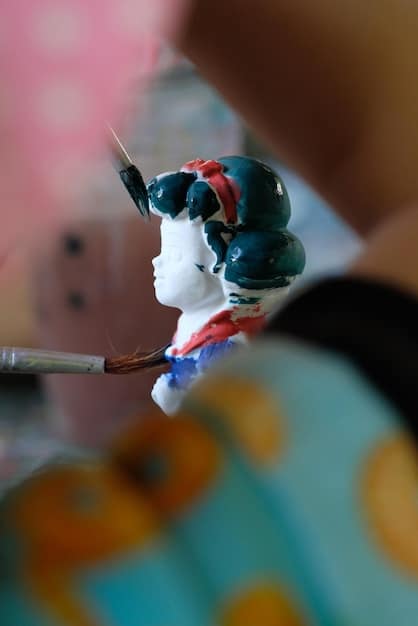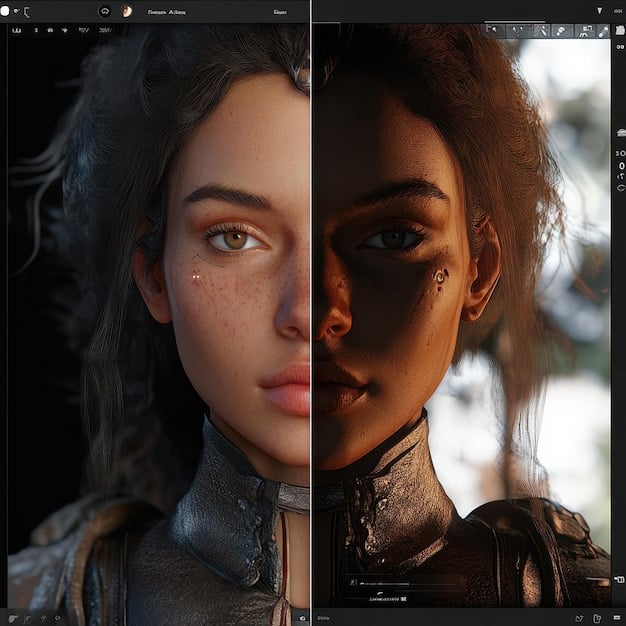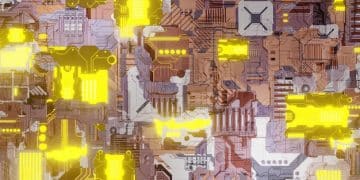Ethical AI: Navigating Art Restoration’s New Frontier

The ethical considerations of using AI in art restoration encompass authenticity, authorship, access, and the potential for bias, requiring careful evaluation and transparent implementation.
The convergence of artificial intelligence and art restoration offers exciting possibilities, but also raises critical questions. What are the ethical considerations of using AI in art restoration? This article explores these concerns, examining the balance between technological advancement and artistic integrity.
The Rise of AI in Art Restoration
Artificial intelligence is rapidly transforming various fields, and art restoration is no exception. With its ability to analyze, replicate, and even predict, AI offers new tools and techniques for preserving our cultural heritage. But with these advancements come significant ethical responsibilities.
Let’s delve into how AI is currently utilized in art restoration and what challenges it presents.
Current Applications of AI in Art Restoration
AI algorithms are being employed in many ways, from detecting damage to reconstructing lost portions of artwork. Understanding these applications is crucial for grasping the ethical implications.
- Damage Detection: AI can identify cracks, discoloration, and other forms of damage in paintings and sculptures with greater speed and accuracy than traditional methods.
- Digital Reconstruction: Algorithms can reconstruct missing pieces or faded sections of artwork, providing a glimpse into the original appearance.
- Material Analysis: AI can analyze the composition of paints and other materials, helping conservators choose the most appropriate restoration techniques.
These applications showcase AI’s potential, highlighting its efficiency and precision. However, they also open up a Pandora’s Box of ethical dilemmas.
Technological advancements in AI facilitate detailed analysis and restoration, but the underlying algorithms and data must be transparent and unbiased to maintain artistic integrity.

Authenticity and Originality
One of the primary ethical considerations revolves around the concept of authenticity. When AI steps in to restore a piece, how much of the “original” artwork remains? Questions arise about what constitutes authenticity in an AI-enhanced restoration.
The debate over authenticity touches on deep philosophical questions regarding artistic creation and preservation. How can art galleries preserve originality when employing AI in art restoration?
Defining Authenticity in the Age of AI
The line between preservation and alteration becomes blurred when AI is involved. Maintaining the integrity of the original artwork is paramount, but how do we ensure this is being upheld?
- Transparency: It is essential to be transparent about the extent to which AI has been used in the restoration process. Documentation should detail what AI did and why.
- Minimizing Intervention: AI should be used to stabilize and preserve the artwork, rather than to drastically alter its appearance. The goal should be preserving what remains, not creating something new.
- Human Oversight: Human conservators should always oversee the AI’s work. Experts must provide context, evaluate the AI’s decisions, and make sure the restoration aligns with established art conservation principles.
An over-reliance on AI could lead to a homogenized view of art, where subtle variations and unique characteristics are ironed out.
When AI makes choices about which colors to restore or how to reconstruct missing elements, it’s critical to question the nature of authenticity and originality.
Authorship and Creative Control
Another thorny issue concerns authorship. In cases where AI significantly contributes to the restoration, does it share some claim to authorship? How does this affect our perception and valuation of art?
Understanding the creator’s intention is key to ethical restoration.
AI as a Collaborator or a Tool?
The role of AI in restoration should be viewed as a tool rather than a collaborator. It assists human experts, but it doesn’t replace their creative and interpretive skills.
- Clear Attribution: It should always be clear that the primary author of the artwork is the original artist, and the role of AI is strictly supportive.
- Avoiding Creative Interpretation: AI should not be used to impose new artistic interpretations or styles onto the artwork. The focus should be on faithfully reconstructing the original vision.
- Maintaining Artistic Intent: Conservators must strive to understand the original artist’s intent and use AI in a way that respects that intent.
The involvement of AI should enhance the original creation, not overshadow or redefine it. In safeguarding our cultural heritage, we must respect the integrity of the artistic process.
The question of authorship is inherently linked to the perception of value. If AI plays too significant a role, it might compromise the perceived value of the artwork.

Access and Equity
Ethical considerations extend to access and equity. AI-powered restoration has the potential to democratize access to art, but it also raises questions about who benefits from these technologies and how to ensure equitable distribution.
AI could provide new opportunities to interact with long-lost masterpieces.
Democratizing Art Through AI
AI-driven restoration can provide new ways for people around the globe to access and appreciate art. But this democratization should occur in a way that is fair and equitable.
- Virtual Museums: AI can enable the creation of highly detailed virtual museums, allowing people to experience art from anywhere in the world.
- Affordable Restoration: AI could reduce the costs of restoration, making it more accessible to smaller museums and cultural institutions.
- Educational Tools: AI-powered restoration can be used as an educational tool, helping people learn more about art history and conservation.
The benefits of AI in art restoration must reach beyond major institutions and private collectors. Policies and initiatives should ensure that these technologies serve the public good.
AI systems should be trained using diverse datasets that accurately represent various artistic styles and cultural contexts. This will help avoid biases and guarantee equitable outcomes.
Cultural Sensitivity and Bias
AI is only as good as the data it’s trained on, and datasets can contain biases that affect the restoration process. Recognizing and mitigating these biases is an ethical imperative.
It is crucial to question the perspectives embedded within AI technologies.
Addressing Bias in AI Algorithms
Algorithms might reflect cultural stereotypes or historical inaccuracies. Conservators must be aware of these potential biases and take steps to mitigate them.
- Diverse Datasets: Training data should encompass a wide range of artistic styles, cultural backgrounds, and historical periods to minimize bias.
- Algorithmic Transparency: The decision-making processes of AI algorithms should be transparent and explainable.
- Expert Review: Human experts from diverse cultural backgrounds should review the AI’s work to identify and correct any instances of bias.
Ensuring cultural sensitivity requires an ongoing process of reflection, adaptation, and collaboration. Failure to address this can perpetuate harmful stereotypes and undermine the very traditions that art aims to preserve.
Ethical considerations for AI extend beyond technical issues, touching on matters of cultural heritage and collective memory. By carefully evaluating and transparently implementing AI, we can ensure it serves to enrich our understanding and appreciation of art.
Transparency and Documentation
Transparency is key to maintaining trust and accountability. Detailed documentation of how AI is used in restoration is essential for ensuring ethical standards are met.
Complete transparency can build trust among stakeholders and the public.
The Importance of Detailed Records
Comprehensive documentation should include details about the algorithms used, the extent of AI intervention, and the rationale behind key decisions. Such records preserve authenticity and trust.
- Algorithm Details: Document the specific algorithms used, including their strengths and limitations. This allows others to understand how the AI arrived at its conclusions.
- Extent of Intervention: Clearly articulate the specific changes the AI made to the artwork. Highlight which parts were reconstructed and which were preserved.
- Rationale: Provide detailed explanations for key decisions, explaining why particular approaches were chosen and what trade-offs were made.
Clear, accessible records can serve educational purposes, helping future conservators learn from past experiences. Establishing standards for transparency and documentation can safeguard the integrity of the field.
Transparency ensures that AI serves as a tool for conservation, augmenting human knowledge rather than replacing it.
The Future of AI and Art Ethics
The field of AI and art restoration is rapidly evolving. We need to anticipate emerging ethical challenges and proactively develop guidelines and best practices.
Looking ahead requires forward thinking and adaptability.
Developing Ethical Guidelines
Collaboration between AI developers, art conservators, ethicists, and policymakers is essential to develop comprehensive guidelines. These guidelines should be regularly updated to reflect new technological advancements and societal values.
- Interdisciplinary Collaboration: Foster collaboration between experts from diverse fields to create holistic ethical frameworks.
- Continuous Learning: Ethical guidelines must adapt to technological changes and evolving societal norms.
- Public Engagement: Encourage open discussions about the ethical implications and involve the public in shaping the future of AI and art.
An ethical compass is essential as we navigate uncharted waters. By prioritizing these values, we can harness AI’s capabilities while upholding the rich legacy of human creativity.
The ongoing dialogue about AI’s role in art restoration is an opportunity to deepen our understanding of art, technology, and the human spirit. With careful planning and thoughtful consideration, we can ensure a future where AI serves to enrich, rather than diminish, our cultural heritage.
| Key Aspect | Brief Description |
|---|---|
| 🖼️ Authenticity | Maintaining the "original" integrity of artwork during AI restoration. |
| ✍️ Authorship | Clarifying roles to ensure AI functions as a tool and not a co-author. |
| 🌐 Access | Promoting fair and equitable access to AI-enhanced art experiences. |
| ⚖️ Bias | Mitigating algorithmic biases to guarantee artwork retains its genuine cultural significance. |
Frequently Asked Questions
▼
AI algorithms detect damage, reconstruct missing parts, analyze materials, and virtually restore artwork. It’s used as a tool for detailed analysis and improvement led by human experts.
▼
To preserve the authenticity, AI should be implemented transparently. With clearly specified AI use and oversight from dedicated human conservators.
▼
The responsibility falls on developers, conservators, and institutions. They must ensure that algorithms are unbiased and regularly checked by humans with diverse cultural expertise.
▼
Museums can offer virtual tours, expand educational programs, and collaborate with smaller institutions. Those collaborations aim to share resources and technology to make AI-restored accessible.
▼
Continuing interdisciplinary dialogue involving multiple perspectives should regularly update related guidelines. As AI technology progresses it is essential to adapt with societal values.
Conclusion
Navigating the ethical considerations of using AI in art restoration requires a balanced approach. By prioritizing authenticity, authorship, access, and cultural sensitivity, while ensuring transparency and ongoing evaluation, we can thoughtfully preserve and enrich our cultural heritage for future generations.





